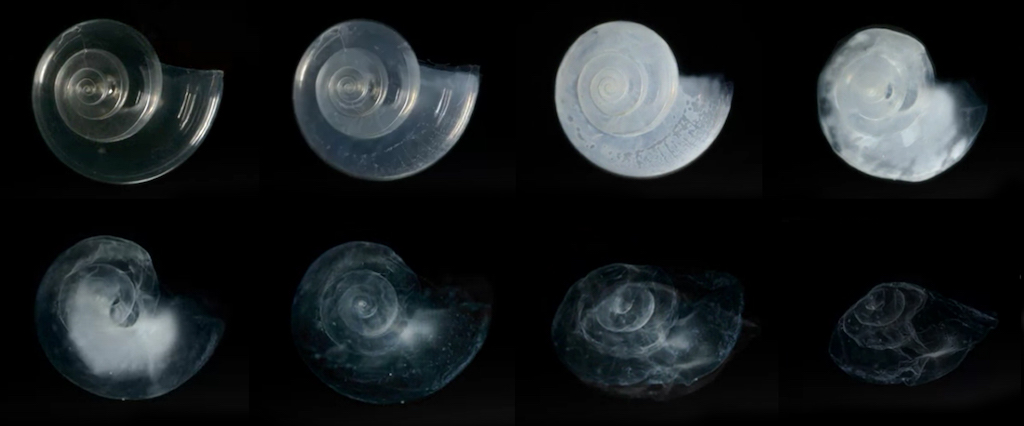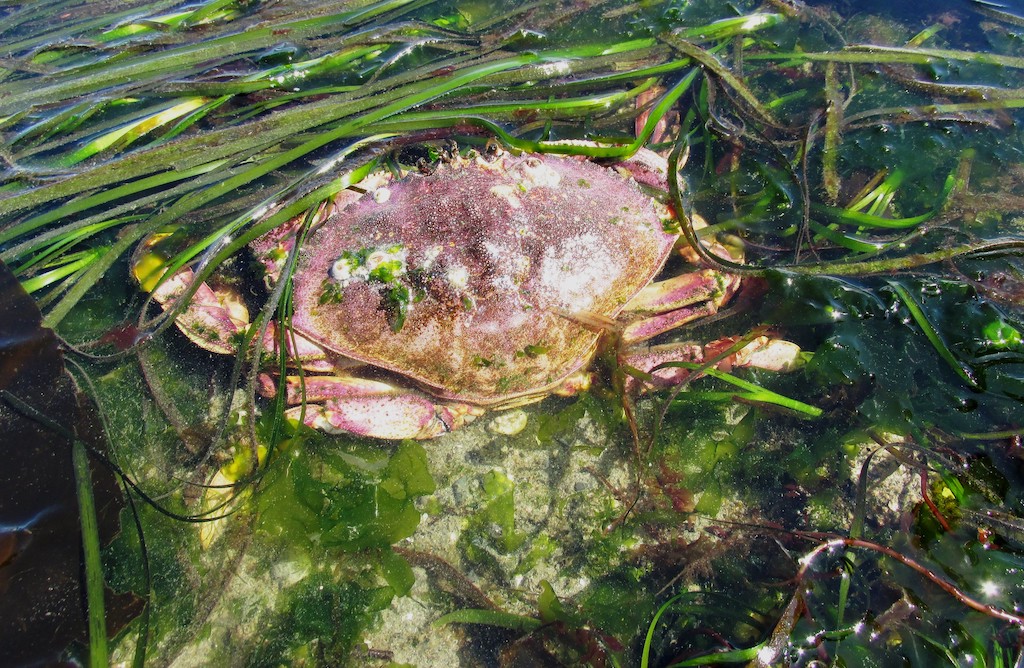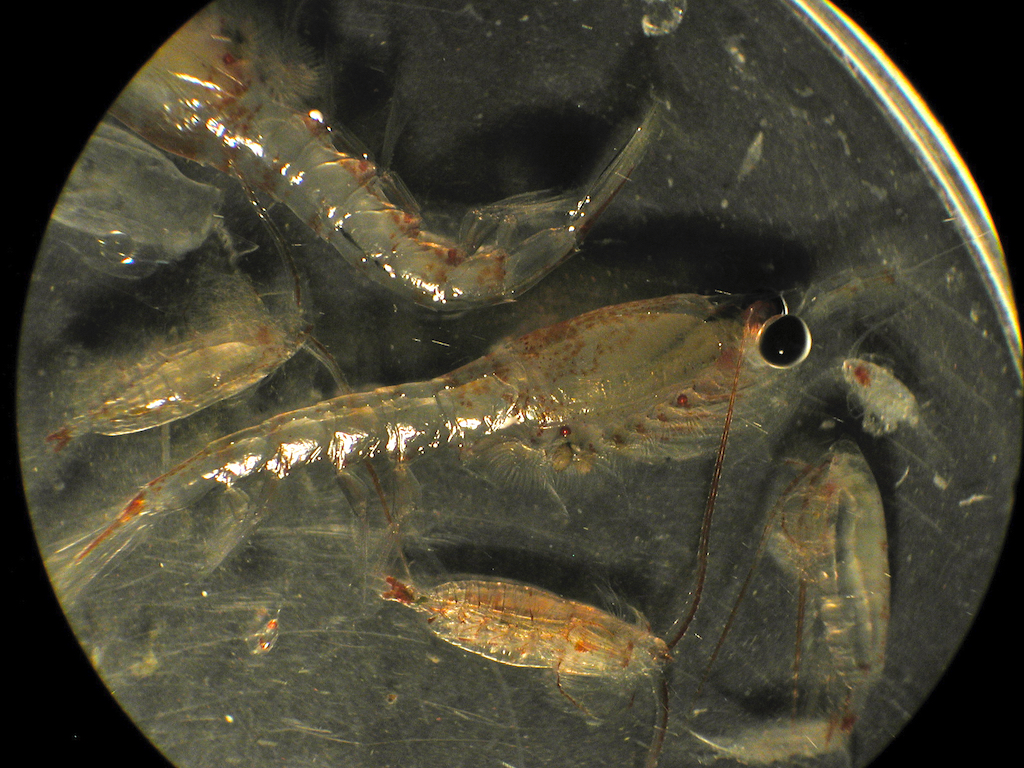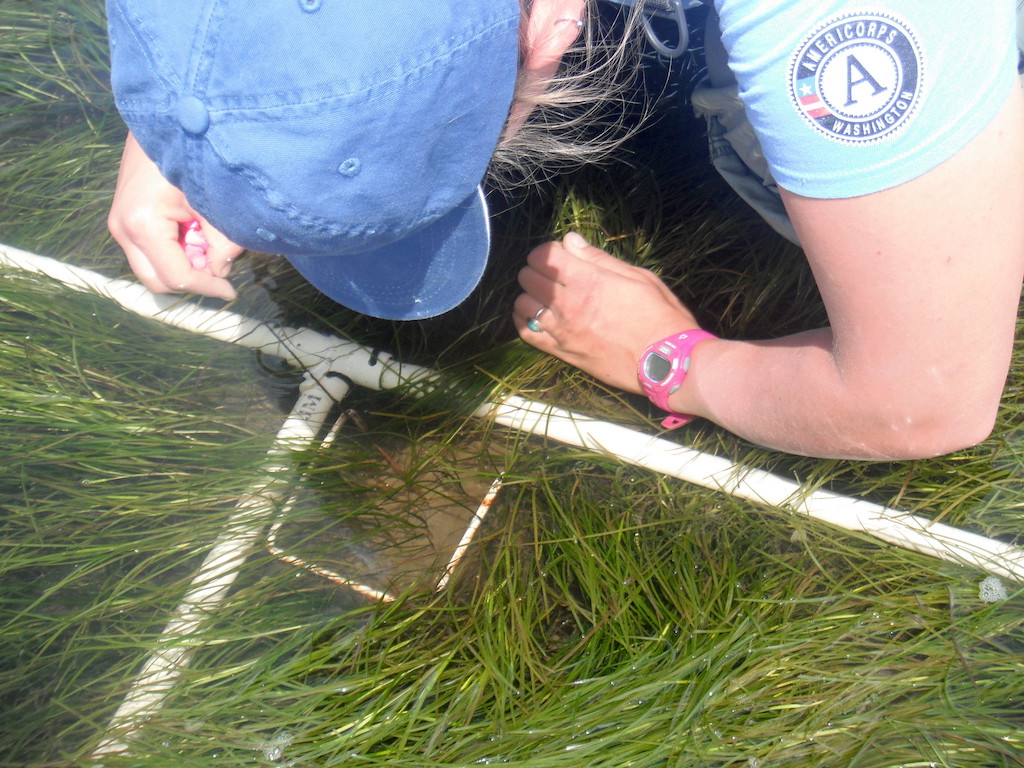Ocean acidification, which threatens sea life throughout the world, is affecting Pacific Northwest waters — including the Salish Sea — sooner than most regions around the globe, according to ongoing studies.
Even more alarming is new research now causing oceanographers to predict that the changes in ocean chemistry will soon pick up the pace, causing the rate of ocean acidification to accelerate.
“If we continue down the road we are on, we will see very dramatic changes in the next 10 to 20 years,” said Richard Feely, senior scientist at NOAA’s Pacific Marine Environmental Laboratory in Seattle.
Ocean acidification, caused by the absorption of more and more carbon dioxide from the atmosphere, can affect the survival, growth and behavior of all kinds of sea creatures. New evidence suggests that ocean acidification impairs the sense of smell in salmon, impedes growth in herring and other critical prey species, and can affect plankton populations, thereby altering the food web.
Most notable in the struggle for survival amid ocean acidification are species that form shells of calcium carbonate — including succulent oysters that support a vast industry, solitary corals that live in local waters, and a wide variety of tiny animals that serve as food for others.
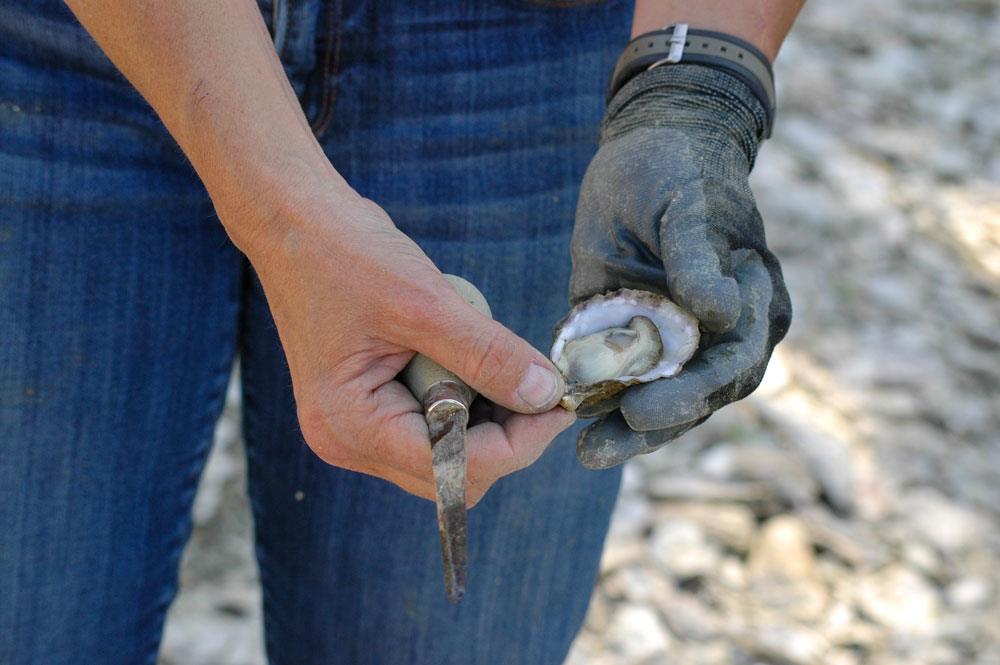
Oyster harvested at Henderson Inlet, WA. Photo: NRCS
These new predictions are the result of a growing understanding of the chemical changes taking place in different parts of the ocean, said Feely, who presented the latest findings during a 2019 Ocean Acidification Science Symposium in Seattle. Of particular concern, he noted, is what could become a dangerous weakening of the ocean’s buffer system — an elegant set of chemical reactions that have so far inhibited an even faster rate of ocean acidification.
Researchers at the symposium also presented new findings about the effects of ocean acidification on salmon, herring, Dungeness crabs, plankton and eelgrass, while others talked about future conditions and what can be done to turn things around.
Ocean chemistry
Over several decades, scientists throughout the world have been joining forces to better understand ocean acidification and its ecological consequences. The Global Ocean Acidification Observing Network, known as GOA-ON, has been compiling and sharing data from a vast array of sources —from stationary monitoring buoys to ocean-going research vessels to merchant ships that carry sensors while delivering cargo around the world.
Researchers have long understood that the ocean is far from uniform when it comes to absorbing and transforming excess carbon dioxide, said Feely, who has been studying ocean acidification for 37 years. New information is helping to explain why Northwest waters are so vulnerable to acidification and why the perils are growing greater as time goes by.
“We’re not there yet, but we’re at a turning point,” he said. “We have to make a decision about what we are going to do. The result (for marine life) will be a function of our decisions.” -- Richard Feely, NOAA
As carbon dioxide increases in the atmosphere from the burning of fossil fuels and from deforestation, about 25 to 30 percent of it gets absorbed into the ocean, where it is transformed into other carbon compounds.
In the North Pacific, subsurface currents along the West Coast carry acidified water northward, where upwelling brings corrosive low-oxygen water up from the depths. That’s why shell-bearing creatures in Washington, Oregon and Northern California are especially vulnerable to ocean acidification.
New studies on pteropods — free-swimming sea snails — have revealed that the shells of these tiny animals collected along the coast are fully one-third thinner than those of pteropods collected in the open ocean, says Nina Bednaršek, senior scientist at the Southern California Coastal Water Research Project. Such studies raise concerns not only for the survival of pteropods but also for the multitude of species that eat them.
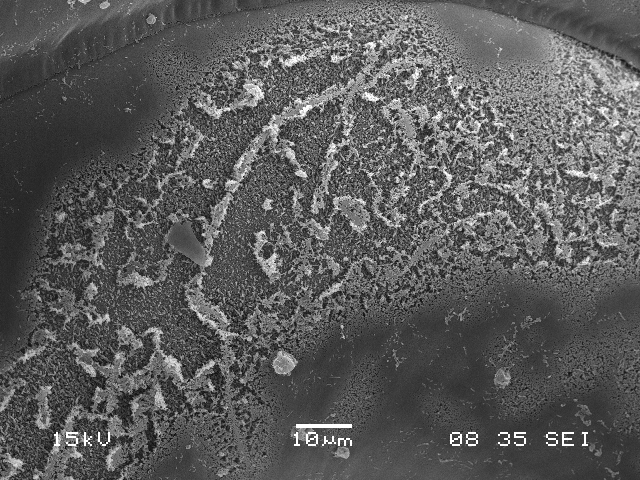
An image from a scanning electron microscope of dissolution on a pteropod shell. Photo courtesy of NOAA.
New evidence also suggests that acidification has already begun to upset the chemical balance of the ocean, including its ratio of buffering chemicals, which so far have helped to quell the rate of acidification. But buffering has its limits. Once a threshold is reached, the rate of acidification is expected to accelerate, like a brakeless freight train on a downhill track.
The chemistry of the ocean is complex, but buffering can be viewed as a balance between two closely related compounds — with carbonate and bicarbonate being the key partners. They can readily change form from one to the other as acidity increases or decreases. This partnership helps to maintain a fairly stable pH — the common measure of acidity.
Buffering comes into play as the ocean absorbs carbon dioxide through direct contact with the atmosphere. As CO2 gas enters the water, it readily converts to carbonic acid and begins to influence the buffer, turning carbonate into bicarbonate. As carbonate is consumed, the rate of acidification increases.
At the same time, the increase in carbon dioxide also influences calcium carbonate — the material of shells. Higher acidity tends to dissolve calcium carbonate molecules into separate calcium and carbonate ions. Thereafter, the reduced concentration of carbonate ion makes this critical mineral less accessible to shell-forming animals. At low concentrations of carbonate ion, favorable chemical reactions can actually run in reverse, dissolving the shells of living creatures.
If concerns about coastal waters are running high, trends for Puget Sound and the entire Salish Sea are raising the loudest alarm bells, Feely said. That’s because freshwater flowing in from rivers and streams lowers the buffering capacity even further through dilution.
In addition, excess nutrients from natural and human sources, such as runoff and sewage-treatment plants, encourage the growth of algae, which eventually die and decay, creating an oxygen deficit and even more carbon dioxide to upset the natural balance.
“We compared the changes in the open ocean right outside the Strait of Juan de Fuca to the changes in Puget Sound on a year-to-year basis,” Feely said. “Puget Sound has much lower pH (higher acidity) and more rapid change because of the lower buffer capacity.”
It turns out that harmfully low calcium carbonate levels are observed in Puget Sound even more frequently than harmful oxygen levels, according Simone Alin, a colleague of Feely's at NOAA.
Continuing on the present course, the outcome will be increasing impairment for marine life in inland waterways — and not just for the Salish Sea but for San Francisco Bay in California and for Prince William Sound in Alaska, Feely told attendees at the ocean acidification symposium.
“Many West Coast estuaries with freshwater inputs will see these impacts,” he said.
Once the buffering capacity reaches a critical threshold, the increase in acidification will occur more rapidly, Feely said, and the cascading effects on marine life will be felt throughout the ecosystem.
“We’re not there yet, but we’re getting near a turning point,” he said. “We have to make a decision about what we are going to do. The result (for marine life) will be a function of our decisions.”
Effects on fish
As ocean acidification continues to intensify, researchers predict uncertain but profound changes in the food web, as each species adjusts to its new conditions — or eventually disappears. For shell-building creatures, the lack of carbonate ion in the water may be observed as weaker shells, assuming the animal can survive. For other animals, behavioral changes may be the most dangerous problem, although behavior can be difficult to study.
Experiments on coho salmon, for example, have shown that when they are in marine waters with low pH (higher acidity), their ability to avoid predators declines and the risk of being eaten rises dramatically.
The cause may be related to changes in blood chemistry and effects on the fish’s ability to sense chemicals in the water, according to researcher Chase Williams and his colleagues at the University of Washington’s Department of Environmental and Occupational Health Sciences and NOAA’s Northwest Fisheries Science Center.
Specifically, the lower pH causes the fish to accumulate more bicarbonate to maintain a stable blood pH, which leads to an excretion of chloride ions, Williams said at the ocean acidification symposium.
“This is important, because the chloride concentration across the cellular membrane in the brain is critical in the signaling pathway,” he said. “When you start reversing certain signals, you start altering the code.”
Using special instruments, Williams’ team was able to find faulty signals in the connections with the olfactory centers responsible for the sense of smell. Fish could smell the odors, but disruptions in the neural pathway altered how they reacted to smells picked up from the water. If a fish can’t tell the difference between predator and prey, it probably won’t last long in the real world.
Salmon also use their sense of smell for mating and finding their way back to their natal waters, Williams said, so learning how a fish responds to different pH levels could determine their chances of survival.
Changes in pH are not the only issue, he noted, because salmon face many other challenges, such as increasing temperatures and low oxygen levels, which also are influenced by climate change. Further studies are focusing on other species of salmon, and Williams is looking into how ocean acidification might affect how the fish use the Earth’s magnetic field to find their way in the open ocean.
Another type of fish creating a lot of interest is Pacific herring, which serves as primary prey for salmon as well as a variety of other marine creatures. Among the first to study the effects of changing ocean conditions on these forage fish is Associate Professor Brooke Love along with graduate student Cristina Villalobos, both at Western Washington University.
Herring eggs were fertilized and hatched in water under normal conditions as well as in water with low pH, similar to what might be seen in Puget Sound in the year 2100. More fish died in the water with the lower pH, Love said. Higher water temperatures, such as future conditions in Puget Sound, produced a similar but even more powerful effect. [Read more about how acidic oceans could affect Pacific herring.]
Together, higher temperature and lower pH were shown to increase the death rate from around 20 percent to more than 50 percent, Love said.
“The conditions we tested are not so far off from what we might expect in the future, so the findings are worrisome,” she said, while pointing out that the results are still preliminary.
Future studies on herring are being planned to:
- examine the effects of rearing the fish at various other temperatures;
- consider whether different populations of herring respond in different ways; and
- determine what physiological changes are triggered by higher temperature and lower pH.
Dungeness crabs
Knowing that Dungeness crabs provide one of the most valuable fisheries on the West Coast, a group of researchers has been figuring out how the crabs are likely to fare in a future Puget Sound. One study at NOAA’s Mukilteo Field Station near Everett began by hatching out some 6,000 crabs and exposing them to varying conditions, such as different levels of oxygen, carbon dioxide and temperature.
In the earliest larval stage, fewer of the crabs survived when exposed to higher-than-normal carbon dioxide levels, according to NOAA researcher Paul McElhany. Among the crabs that did survive, researchers noted a slowing of their development, he said.
In a related experiment, older juvenile crabs, which began their lives in the wild, seemed to be unaffected by higher CO2 levels, but more studies are needed to confirm this result, he said. Further experiments will examine how even older juveniles and adults in the population could be affected by ocean acidification.
By studying the metabolism of these crabs under varying conditions, the researchers are hoping to explain the physiological changes that Dungeness crabs go through and what it will mean to the future of the wild population, said Shelly Trigg, another NOAA and UW researcher. So far, lab experiments seem to show that low-oxygen conditions trigger more pronounced changes than higher levels of acidity alone, she said.
McElhany noted that populations of Dungeness crabs have dramatically declined in recent years in both South Puget Sound near Olympia and in Southern Hood Canal near Hoodsport — waters known to have high levels of carbon dioxide. Because of dwindling crab populations in those areas, sport and commercial crabbing has been closed, and crabbers are left wondering what the future may hold.
While it might be easy to pin the blame on high carbon dioxide and low oxygen, McElhany said one must be careful not to become fixated on a single possible cause. “There are a lot of things going on that may be a primary driver for this population, but CO2 is something we need to consider.”
Plankton and vegetation
At the base of the food web, supporting a multitude of life forms, are tiny plankton, made up of thousands of different oceanic species. They include plantlike phytoplankton, which get their energy directly from the sun, and zooplankton, which survive by eating other organisms. Some plankton, known as mixotrophs, can do both.
Ocean acidification can have profound effects on the growth and composition of the entire planktonic community, thus influencing the success and survival of many higher animals. Since zooplankton include the larval stages of some larger animals — such as oysters and crabs — harsh conditions decimate populations before the young ever reach maturity.
Evelyn Lessard, Julie Keister, and their associates at the UW School of Oceanography keep watch on how the plankton are doing by examining water samples taken three times a year from seven monitoring stations throughout Puget Sound. Populations of various species expand and contract, as conditions constantly change, month-to-month and year-to-year.
Species most likely to be impaired by ocean acidification are those that form shells or other calcium carbonate structures, including:
- pteropods and gastropods (sea snails), which offer a key food supply for fish;
- shrimp, clams and oysters, which are economically valuable;
- echinoderm larvae, including young sea stars and sea urchins;
- krill, which feed whales, birds and fish; and
- amphipods and copepods, tiny shrimplike creatures that also provide food for fish and other animals.
Plankton surveys of Puget Sound have revealed where all these creatures are found at different times of the year and under different conditions, as Lessard reported during the symposium. So far, even the most sensitive types of zooplankton have survived, she said, although their numbers may be diminished at certain times and in certain areas.
Meanwhile, a research group at the Washington State Department of Natural Resources has been monitoring nearshore conditions in Puget Sound since 2015 to detect any rapid or ongoing ecological changes.
Measurements of water chemistry, shellfish growth and eelgrass density are being collected at nine sites in Puget Sound plus Willapa Bay on the outer coast. By taking measurements inside and outside eelgrass beds, the researchers are hoping to determine if the aquatic plants can reduce the effects of ocean acidification by removing carbon dioxide from the water and adding oxygen through photosynthesis, according to a presentation by Micah Horwith, coastal scientist with DNR.
At least in some eelgrass beds, oxygen levels were dramatically higher during summer daylight hours when photosynthesis was humming along. Over longer periods, however, no general patterns emerged to show how eelgrass might be influencing water chemistry.
Nevertheless, experiments with oysters planted both inside and outside of eelgrass beds seemed to show very real benefits from the vegetation. The experiments, which included commercially valuable Pacific oysters as well as native Olympia oysters, examined many factors, from biochemical makeup of the oysters to their shell structure.
“Really broadly speaking, for Olympia oysters we have seen a general pattern of enhanced growth inside of eelgrass,” Horwith said. “This is not a minor thing. Typically we have seen in 2016 and ’17 a boost of about 30 percent in the growth rate of oysters inside of seagrass.”
In 2018, using a somewhat different approach, the researchers found no difference in growth inside and outside of eelgrass beds. But this year, using even more experimental sites, Olympia oysters within eelgrass beds are showing a clear pattern of more rapid growth.
Limited work with Pacific oysters has so far shown a pattern consistent with Olympia oysters. On the other hand, similar experiments with Manila clams showed unexplained reduced growth. For geoduck clams, no significant difference has been seen so far.
“This, to me, illustrates the importance of working species by species,” Horwith said. “Even in the same functional group, there can be big differences in the way they interact with water chemistry.”
Environmental DNA
While many researchers are studying how individual species respond to ocean acidification, one group from the UW’s School of Marine and Environmental Affairs is using DNA to ask a different question.
“We go out into the world and ask ‘What’s there?’” says ecologist Ryan Kelly, whose work with other researchers involves a search for DNA that has been shed by organisms into the surrounding environment. This approach is referred to as environmental DNA research, or eDNA for short.
“Every living thing has DNA and is leaving that DNA in the environment,” Kelly said, explaining the concept at the symposium. “Whether you are a many-celled porpoise or a single-celled dinoflagellate, you have DNA, and so we can go and collect that.”
Simply put, researchers filter samples of water and run genetic tests to see which species have left their DNA behind. The results provide a good idea of what is living in a given area — and what is not.
In eDNA studies in Hood Canal and the San Juan Islands, more than 400 different kinds of plankton were found throughout the year. An analysis led by Ramòn Gallego in Kelly’s lab helped to reveal which plankton — including harmful species — showed up under various water conditions and where they were likely to appear at different times of the year.
An alternative approach in studying eDNA is to focus on a single species to see how the concentration of DNA differs from place to place or over time in one location. Conditions may dictate whether one place is more hospitable to a species than another or whether the species might do better in summer or winter.
Kelly showed his audience an animated map of Puget Sound, which changed to reveal monthly variations in the relative populations of Alexandrium, a toxic species of plankton responsible for paralytic shellfish poison, which can be deadly to humans. During August 2017, high levels of DNA from Alexandrium suggested that a plankton bloom was underway in southern Hood Canal near Hoodsport.
In another study in Kelly’s lab, Kelly Cribari discovered quantities of DNA related to a group of plankton called Kareniaceae, which has been identified by other researchers as new potentially toxic alga. While nearly absent in waters with normal acidity, eDNA of this species has been found repeatedly in areas with lower pH. These new findings suggest that these plankton could become a growing problem in Puget Sound as ocean acidification intensifies.
Predicting future damage
Extensive monitoring of Puget Sound waters provides a fairly up-to-date picture of water conditions, such as temperature, dissolved oxygen, acidity and so on. But these numbers alone don’t describe the potential for damage that occurs to marine life when water quality gets out of whack.
Now, thanks to a team of scientists focused on biological effects, red flags can be raised to signal serious problems for certain organisms when water-quality measurements reach dangerous thresholds. The team is led by Nina Bednaršek, senior scientist at the Southern California Coastal Water Research Project, who presented the latest threshold findings during the ocean acidification symposium.
Bednaršek and colleagues used pteropods, a group of sea snails, to identify dangerous thresholds. These tiny animals are an important food source for many marine species, and they have been studied extensively for their sensitivity to ocean acidification. Specifically, their shells, which are made of calcium carbonate, do not grow properly in waters with low carbonate ion concentrations — so water chemistry becomes a life-or-death matter.
Besides a low concentration of carbonate ion, the time of exposure in corrosive waters can affect the severity of damage. Both ion concentration and the duration of exposure are used to estimate thresholds beyond which pteropod growth and survival will be impaired. For example, pteropod eggs may fail to develop in water low in carbonate ion — even when the exposure is for just two days. On the other hand, pteropod adults are likely to survive longer in the same water, perhaps because their shells are already complete. Studies have identified threshold levels for mild and severe shell dissolution, as well as other negative biological responses.
Published thresholds — which include bothe the magnitude and duration of stressful conditions — have been derived through a consensus of a dozen or more experts familiar with ocean acidification effects on specific species. Besides pteropods, thresholds have been developed — but not yet reported — for echinoderms, such as sea stars and sea urchins. Thresholds for Dungeness crabs are under development.
When combined with real-time temperature and chemical data gathered from monitoring buoys and other sources, one can get an understanding of the type of damage taking place over time. Bednaršek said conditions in Puget Sound often reach harmful levels for all stages of pteropods, especially in Hood Canal, South Sound and Whidbey Basin.
One can also combine predictive models with biological thresholds to anticipate problems for specific species. For example, the Salish Sea Model, under development by the Washington Department of Ecology, is designed to predict water chemistry based on a number of factors — including the amount of nutrients from natural and human sources coming into Puget Sound.
Based on that modeling, excess nutrients — such as nitrogen from sewage-treatment plants — may contribute to water conditions that can cause thresholds to be exceeded for pteropods and larval Dungeness crabs in parts of Puget Sound.
Thresholds for Dungeness crabs and other commercial species could be used in the future to help estimate economic losses from ocean acidification, whether caused by nutrient loading or atmospheric deposition.
A different kind of predictive model discussed at the symposium, called LiveOcean, is designed to produce daily forecasts of underwater conditions likely to occur over the coming three days. Similar to a weather forecast, the model uses up-to-date information on currents and other physical and chemical properties to predict changes in water conditions in the Salish Sea and along the coast.
LiveOcean can predict when and where pH will dip to dangerous levels, the potential course of toxic algal blooms, and likely pathways for incursions of aquatic invasive species, such as European green crabs, according to UW oceanographer Parker MacCready, who led the effort to develop the model.
One of its most important applications — and the initial motivation for building the model — is to help shellfish growers avoid harmful waters when planting oyster seed and operating oyster hatcheries, MacCready explained.
Oceanographer Samantha Siedlecki reported on an analysis that looked out to the year 2100, showing that many ocean conditions along the West Coast are likely to become more severe — more harmful to sea life — than predicted by global models.
The analysis, which involved numerous collaborators, considered how local factors — such as coastal currents, upwelling and biological activity — tend to “amplify” projections developed at a global scale, said Siedlecki, a former UW research scientist now based at the University of Connecticut.
While the new analysis showed a rate of acidification fairly consistent with global models, levels of temperature and carbon dioxide are projected to be adversely higher in the year 2100 — much higher in some areas. Likewise, beneficial oxygen and carbonate ion concentrations are predicted to be lower than global projections would suggest, and the amount of time that dangerous low-oxygen levels are present could double by 2100 in several coastal areas.
Moderator Jan Newton, a UW oceanographer, said it was important to recognize the capabilities of experts in this region who are developing “really sophisticated hydrodynamic models” to calculate future ocean conditions.
“I really want to acknowledge the groundbreaking work that is going on here, and thank you all,” she said.
State policies and communication
Ocean acidification can be a daunting problem for scientists, politicians and the public, but Washington state has consistently stepped up to the challenge, according to Jennifer Hennessey, senior policy adviser to Gov. Jay Inslee.
In 2012, she said, Washington was the first state to address the problem of ocean acidification with the release of a comprehensive plan containing six broad strategies:
- Reduce carbon emissions, such as from power generation and transportation, while improving energy efficiency,
- Reduce land-based contributions to ocean acidification, such as from sewage systems, agriculture and development,
- Increase adaptation to change, such as by restoring shoreline habitats, recycling seaweed for upland uses and propagating native species to maintain biodiversity,
- Invest in science to enhance understanding and reveal new approaches to the problem,
- Inform and engage stakeholders, leaders and the public, and
- Maintain a sustainable focus on ocean acidification through policy and science coordination.
“Washington’s strategy catalyzed ingenuity across the state and partnerships up and down the West Coast,” Hennessey said during the symposium. “The state has invested millions in ocean acidification work. We’ve leveraged federal resources that are here — we are very lucky to have them here — and we have attracted private financing, too.”
Progress has been made on all six of those fronts, as identified in a 2017 update by the Marine Resources Advisory Council, she said. And this year the state took a big step forward when the Legislature doubled the state’s investment in ocean acidification — including money for a variety of scientific studies. Lawmakers also approved a package of governor-proposed initiatives, including mandates requiring only renewable energy supplies by 2045 along with new building-efficiency standards.
“Our action plan is held up as an example of how to move from a problem to action,” Hennessey said, adding that Washington is collaborating with other states, including Oregon and California. Those states were represented at the symposium by Steve Weisberg of the Southern California Coastal Water Research Project and Charlotte Whitefield of the Oregon Coordinating Council on Ocean Acidification and Hypoxia. Both Weisberg and Whitefield said their states are working from action plans similar to Washington’s.
“We are elevating this issue through various forums, including the launch of the International Alliance to Combat Ocean Acidification,” Hennessey said.
She noted that the organization has grown to more than 80 members —including 10 states and provinces, 12 nations, seven tribes and four cities, plus dozens of businesses and nonprofit groups along with educational and research institutions.
“Our partnerships are playing an important role, but we need to do more,” Hennessey said. “We need to expand the breadth and depth of those partnerships, and we need to get beyond the usual circle of people in this room.
“We need to connect with people first. Why should they care? We need to make it relevant to the audience … and we need to identify actions,” she continued. “Without this connection, people are left wondering what they should do and feeling somewhat helpless with those curves (on graphs) that Dick (Feely) started us off with early in the day.”
Moderator Jan Newton said she thought she heard gasps in the room when Feely outlined the frightening path forward, as ocean acidification picks up its pace because of changes in ocean chemistry.
“We are understanding so much more and becoming more knowledgeable about this issue,” Newton said. “Not only are we are dedicated to our science, we also have a huge responsibility to society. Fruitful collaborations across agencies and institutions are essential to addressing this problem, as is clear communication to the public.”
Communication with the public, she concluded, is being planned to outline the problem in some detail and gain momentum for a different path to the future.
